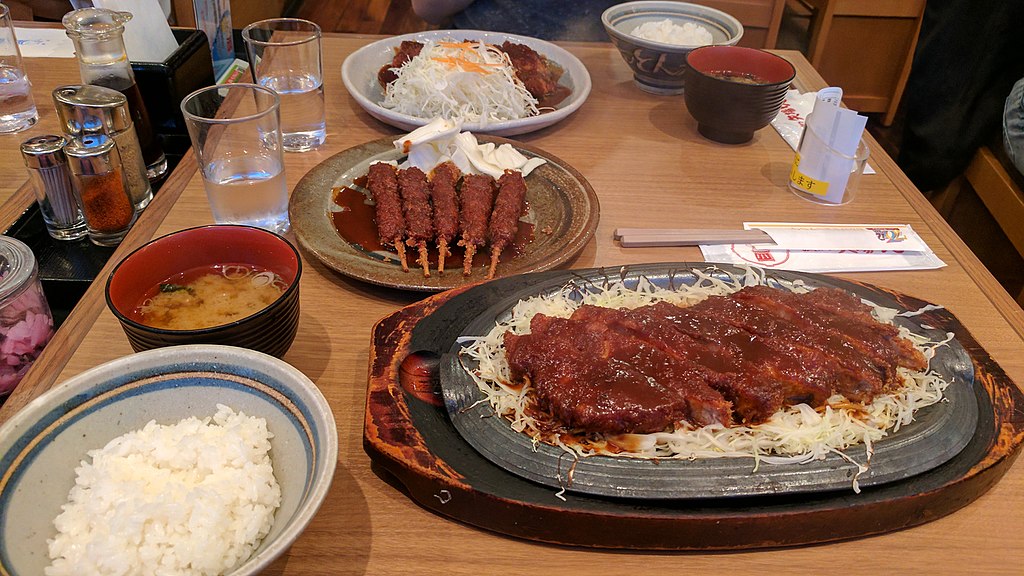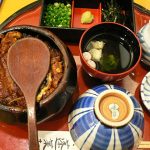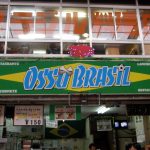Miso Katsu, a dish that began as a part of the ‘yo-shoku’ movement, is now inextricably linked with Nagoya’s culinary identity. Originally derived from ‘katsureto,’ a nod to the English ‘cutlet,’ this dish has undergone a unique transformation in Nagoya. Unlike the standard tonkatsu in Japan, often served with a ketchup and Worcester sauce mix, Nagoya’s version embraces the local love for miso, particularly hacchou miso, replacing the conventional sauce with a miso-based concoction.
Red Miso: Nagoya’s Robust Flavor Powerhouse
Red miso, also known as “Aka Miso” in Japanese, is an indispensable ingredient in Japanese cuisine. It is loved for its rich flavors and nutritional benefits. It distinguishes itself from other types of miso due to its unique features that make it an essential component in many Japanese dishes.
Red miso is primarily made of soybeans, salt, and koji, a type of fungus called Aspergillus oryzae. Its longer fermentation period, lasting up to three years, is the defining characteristic of red miso. This extended fermentation time, often in natural conditions, gives it its darker color, richer taste, and firmer texture. The higher ratio of soybeans to rice or barley used in other miso varieties also contributes to its distinct profile.
Red miso is known for its bold, pungent, salty flavor with underlying umami notes. This complexity results from the Maillard reaction and other chemical processes during its long fermentation. Its taste can range from slightly sweet to very salty, with nuances that may include earthy, smoky, or even fruity undertones. Its robustness makes it ideal for heartier dishes, adding depth and richness to the flavor palette.
Red miso is nutritionally rich, containing various vitamins (B2, E, K), minerals (calcium, iron, potassium), dietary fibers, and protein. The fermentation process also promotes the growth of beneficial bacteria, making it a probiotic food that can aid in digestion and gut health. However, it is high in sodium, so consumption should be moderated, especially for those watching their salt intake.
In Japanese cuisine, red miso is versatile, used in a range of dishes. It serves as the base for many soups, including the robust miso soup varieties that accompany heartier meals. It is also used in marinades and glazes for meats and vegetables, adding a rich umami flavor.
Hacchou Miso
Hacchou Miso is a particular type of red miso that is an integral part of the culinary traditions of Nagoya and its surrounding region of Aichi Prefecture. Its unique production process and resulting flavor set it apart from other types of miso found in Japan.
Hacchou Miso has its origins in Okazaki, which is located in Aichi Prefecture. The name “Hacchou” has a historical connection to the area, as it originally referred to an old Japanese unit of measurement. The production of Hacchou Miso relies on traditional methods and is a time-honored process. The key ingredients are simple: soybeans and salt, with no grains like rice or barley commonly used in other miso varieties.
The soybeans are cooked and mashed before being mixed with salt. Koji, a fermentation starter, is then added to the mixture, which is left to ferment. The fermentation process for Hacchou Miso is lengthy, often lasting up to two years or more, significantly longer than many other miso types. This extended fermentation usually occurs in large wooden barrels, contributing to the miso’s distinct flavor and texture.
As a result of this meticulous fermentation process, Hacchou Miso has a robust and full-bodied flavor. It is characterized by its deep, earthy flavor and rich umami profile, with a more robust and saltier taste than sweeter, lighter misos. Its texture is notably thicker and less smooth due to the absence of grains and the prolonged fermentation. The color is a deep brown, almost chocolate-like, making it visually distinct.
In Nagoya and its surrounding areas, Hacchou Miso is more than just an ingredient; it’s a culinary staple that defines the region’s flavor palette. It is central to the preparation of Miso Katsu, where its bold taste perfectly complements the fried pork cutlet. The miso’s robust flavor is also ideal for hearty soups, marinades, and glazes, infusing dishes with a depth of flavor that is hard to replicate with other miso varieties.
Where to Find Miso Katsu
With it being Nagoya’s best-known dish, restaurants all around the city serve up miso katsu, and when it comes to quality, you pretty much can’t miss it. However, some places do it better than others, and the restaurants below are generally considered the Kings of Katsu!
Yabaton
Yabaton symbolizes Nagoya’s culinary heritage, famous for its Miso Katsu. Its founder opened the restaurant in Osu Kannon in 1947, and since then, it has become an institution. The pork cutlet dish coated in special red miso sauce is an art form made from high-quality meat and matured hacchoumiso. The atmosphere is lively yet welcoming, reflecting Nagoya’s history and culture. Yabaton has evolved to include modern interpretations of Miso Katsu, remaining relevant and beloved by multiple generations.
Where: 3 Chome-6-18 Osu, Naka Ward (map)
Website: yabaton.com
Kitchen Matsuya
Kitchen Matsuya, a culinary stalwart for over half a century, offers a unique twist on the traditional miso katsu. Known for its ankake miso katsu, the dish combines Japanese and French culinary techniques. The miso sauce, rather than being generously slathered, is delicately applied, allowing the breadcrumbs to absorb it, ensuring a rich flavor in every bite. Paired with a glass of red wine, this dish offers a gourmet experience that transcends cultural boundaries.
Where: 1-20-22, Nishiki, Naka-ku, Nagoya-shi, Hirokoji YMD Building 1-2 Floor (map)
Website: kitchen-matsuya-nagoya.com
Tonpachi
celebrating over three decades in the business, Tonpachi has carved out a niche with its unique take on tonkatsu. The pork used here is the tender kenkobuta from Gifu, known for its juiciness. Tonpachi’s miso sauce is lighter and sweeter than the traditional Nagoya style, offering a pleasant alternative for those who prefer a subtler flavor. Their cheese katsu is also a standout, offering a mouthwatering blend of creamy and crispy textures.
Where: 3 Chome-17-15 Chiyoda, Naka Ward (map)
Website: tonpachi.jp
Douglas(大元) from Taiwan (Republic of China), CC BY-SA 2.0, via Wikimedia Commons





